Operation Management 1931: Inventory and Forecasting Analysis
VerifiedAdded on 2023/01/11
|8
|1028
|40
Homework Assignment
AI Summary
This document presents a comprehensive solution to an operation management assignment. It begins with a calculation of the Economic Order Quantity (EOQ) and related costs, including annual demand, ordering costs, and carrying costs. The solution then proceeds to a forecasting problem, utilizing a linear forecasting model to estimate sales for a future year. The assignment also delves into the importance of inventory management, discussing its role in maintaining optimal inventory levels and predicting potential needs. Furthermore, it explores various inventory management methods such as Last In First Out (LIFO), First In First Out (FIFO), and the Weighted Average Cost method, providing detailed explanations of each. The document concludes with a list of references.

Operation Management 1931
Paraphrase This Document
Need a fresh take? Get an instant paraphrase of this document with our AI Paraphraser
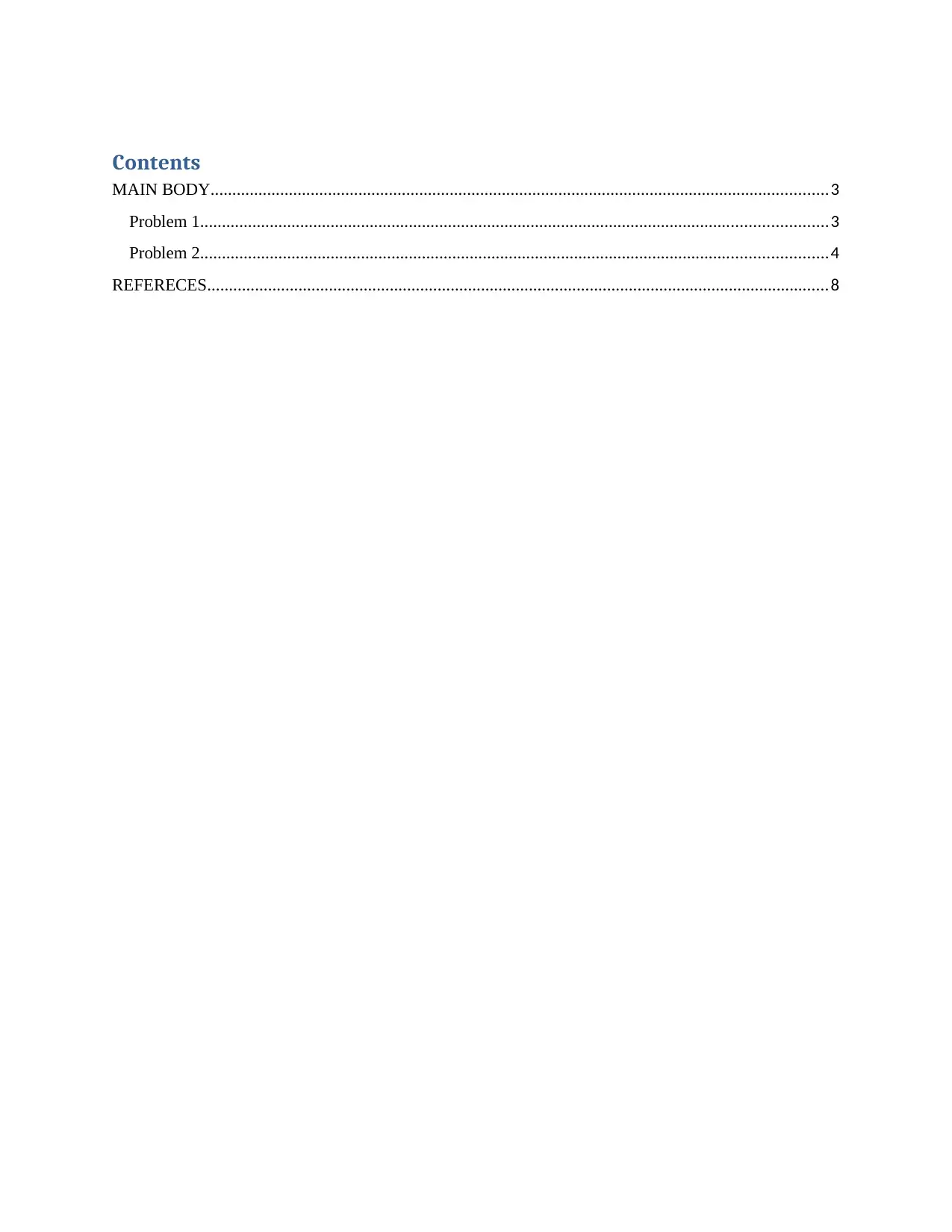
Contents
MAIN BODY..............................................................................................................................................3
Problem 1................................................................................................................................................3
Problem 2................................................................................................................................................4
REFERECES...............................................................................................................................................8
MAIN BODY..............................................................................................................................................3
Problem 1................................................................................................................................................3
Problem 2................................................................................................................................................4
REFERECES...............................................................................................................................................8
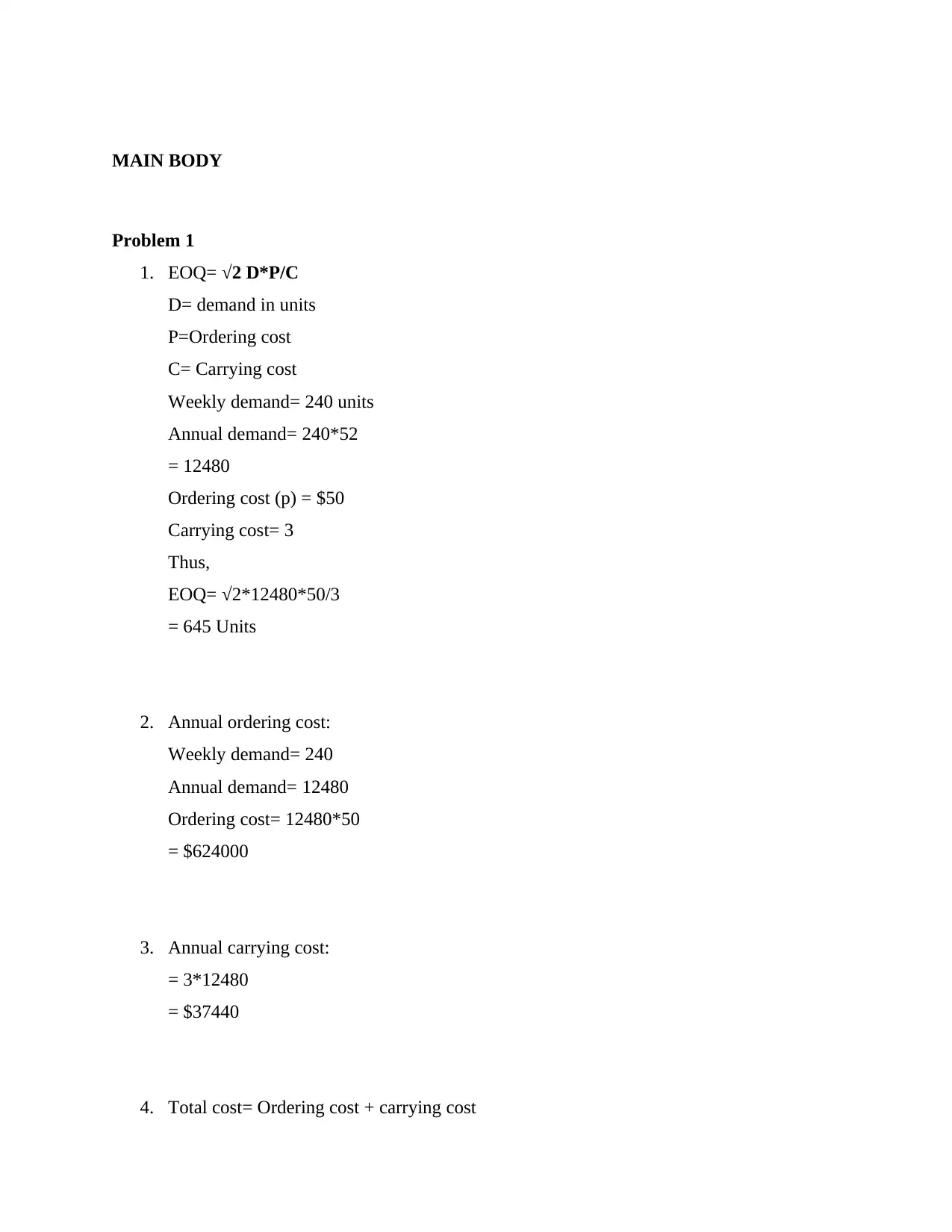
MAIN BODY
Problem 1
1. EOQ= √2 D*P/C
D= demand in units
P=Ordering cost
C= Carrying cost
Weekly demand= 240 units
Annual demand= 240*52
= 12480
Ordering cost (p) = $50
Carrying cost= 3
Thus,
EOQ= √2*12480*50/3
= 645 Units
2. Annual ordering cost:
Weekly demand= 240
Annual demand= 12480
Ordering cost= 12480*50
= $624000
3. Annual carrying cost:
= 3*12480
= $37440
4. Total cost= Ordering cost + carrying cost
Problem 1
1. EOQ= √2 D*P/C
D= demand in units
P=Ordering cost
C= Carrying cost
Weekly demand= 240 units
Annual demand= 240*52
= 12480
Ordering cost (p) = $50
Carrying cost= 3
Thus,
EOQ= √2*12480*50/3
= 645 Units
2. Annual ordering cost:
Weekly demand= 240
Annual demand= 12480
Ordering cost= 12480*50
= $624000
3. Annual carrying cost:
= 3*12480
= $37440
4. Total cost= Ordering cost + carrying cost
⊘ This is a preview!⊘
Do you want full access?
Subscribe today to unlock all pages.

Trusted by 1+ million students worldwide
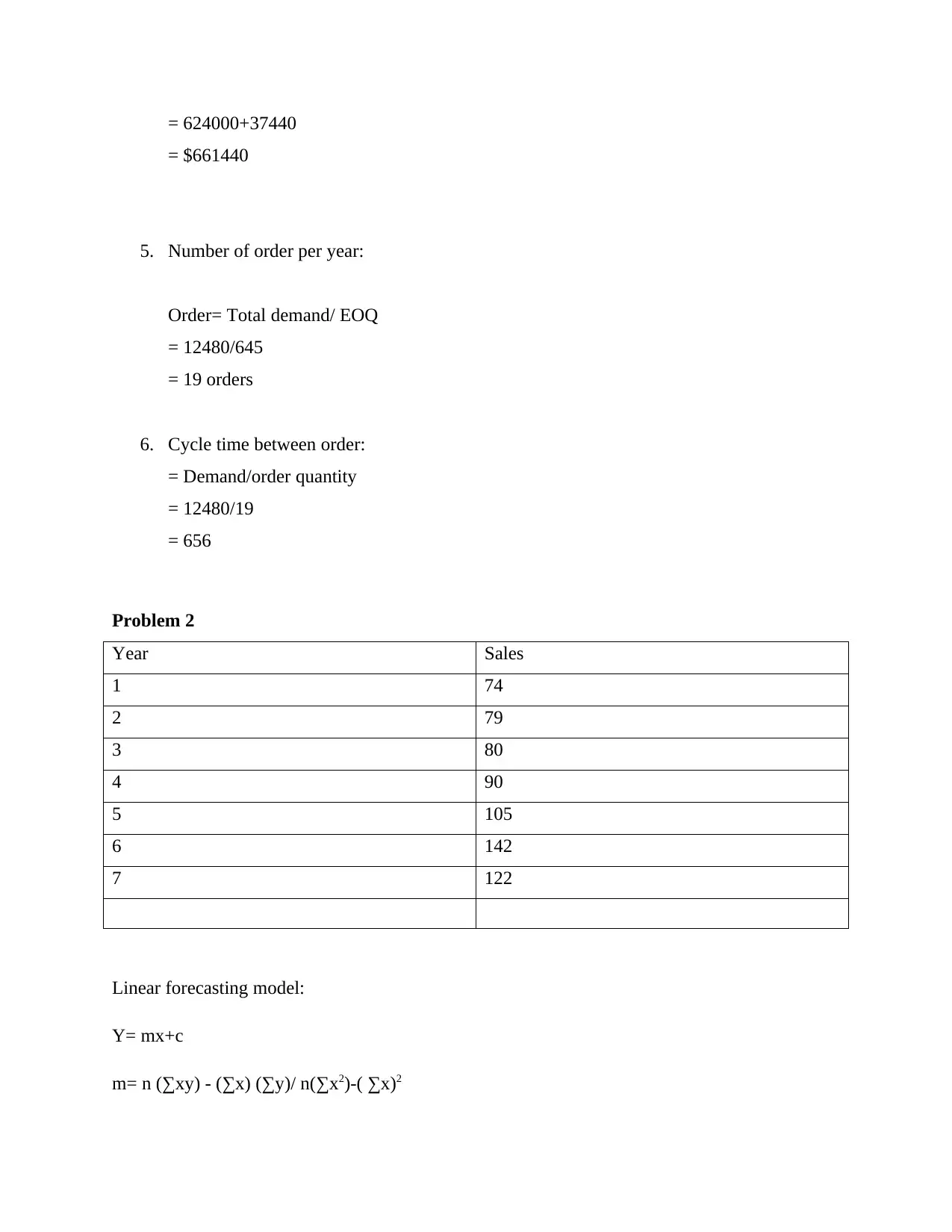
= 624000+37440
= $661440
5. Number of order per year:
Order= Total demand/ EOQ
= 12480/645
= 19 orders
6. Cycle time between order:
= Demand/order quantity
= 12480/19
= 656
Problem 2
Year Sales
1 74
2 79
3 80
4 90
5 105
6 142
7 122
Linear forecasting model:
Y= mx+c
m= n (∑xy) - (∑x) (∑y)/ n(∑x2)-( ∑x)2
= $661440
5. Number of order per year:
Order= Total demand/ EOQ
= 12480/645
= 19 orders
6. Cycle time between order:
= Demand/order quantity
= 12480/19
= 656
Problem 2
Year Sales
1 74
2 79
3 80
4 90
5 105
6 142
7 122
Linear forecasting model:
Y= mx+c
m= n (∑xy) - (∑x) (∑y)/ n(∑x2)-( ∑x)2
Paraphrase This Document
Need a fresh take? Get an instant paraphrase of this document with our AI Paraphraser
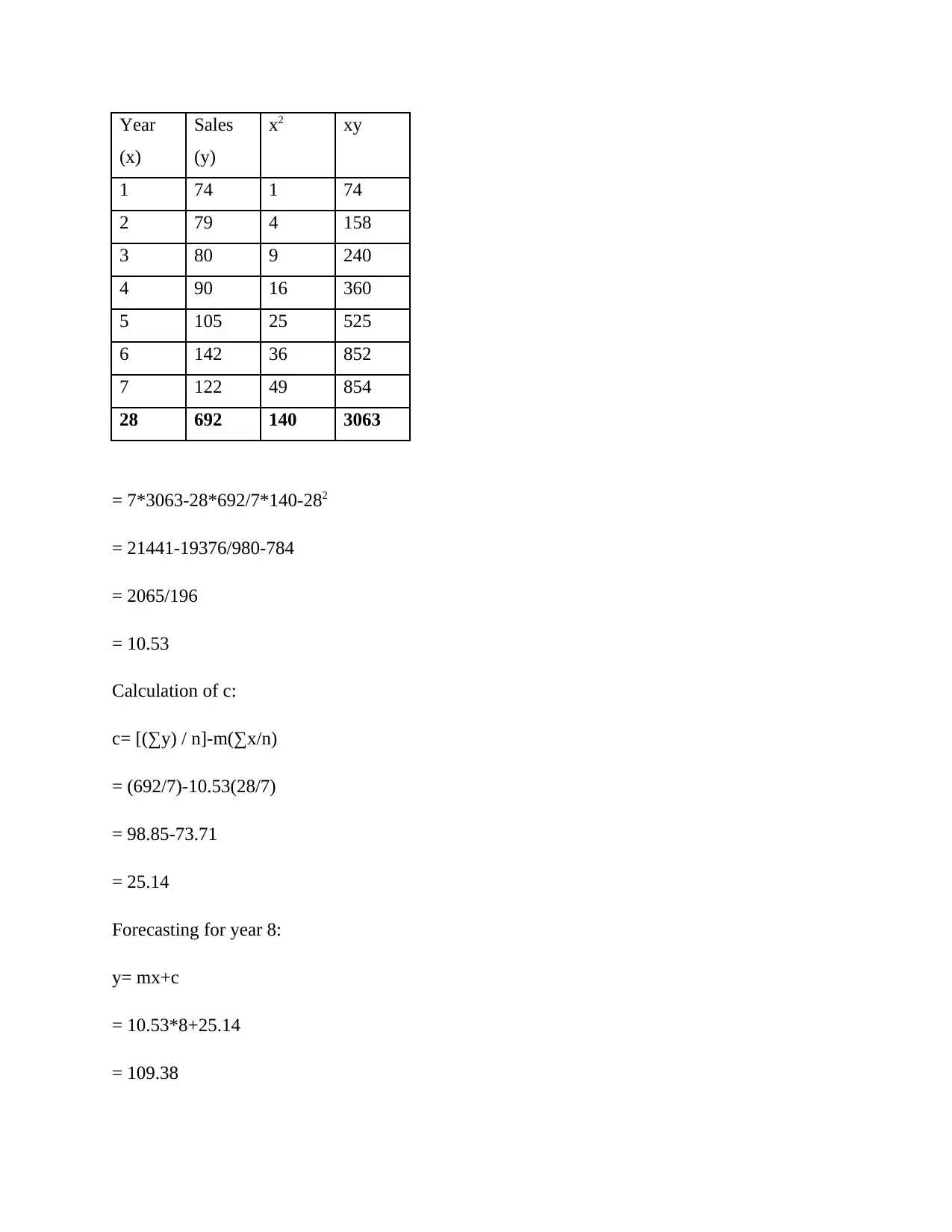
Year
(x)
Sales
(y)
x2 xy
1 74 1 74
2 79 4 158
3 80 9 240
4 90 16 360
5 105 25 525
6 142 36 852
7 122 49 854
28 692 140 3063
= 7*3063-28*692/7*140-282
= 21441-19376/980-784
= 2065/196
= 10.53
Calculation of c:
c= [(∑y) / n]-m(∑x/n)
= (692/7)-10.53(28/7)
= 98.85-73.71
= 25.14
Forecasting for year 8:
y= mx+c
= 10.53*8+25.14
= 109.38
(x)
Sales
(y)
x2 xy
1 74 1 74
2 79 4 158
3 80 9 240
4 90 16 360
5 105 25 525
6 142 36 852
7 122 49 854
28 692 140 3063
= 7*3063-28*692/7*140-282
= 21441-19376/980-784
= 2065/196
= 10.53
Calculation of c:
c= [(∑y) / n]-m(∑x/n)
= (692/7)-10.53(28/7)
= 98.85-73.71
= 25.14
Forecasting for year 8:
y= mx+c
= 10.53*8+25.14
= 109.38
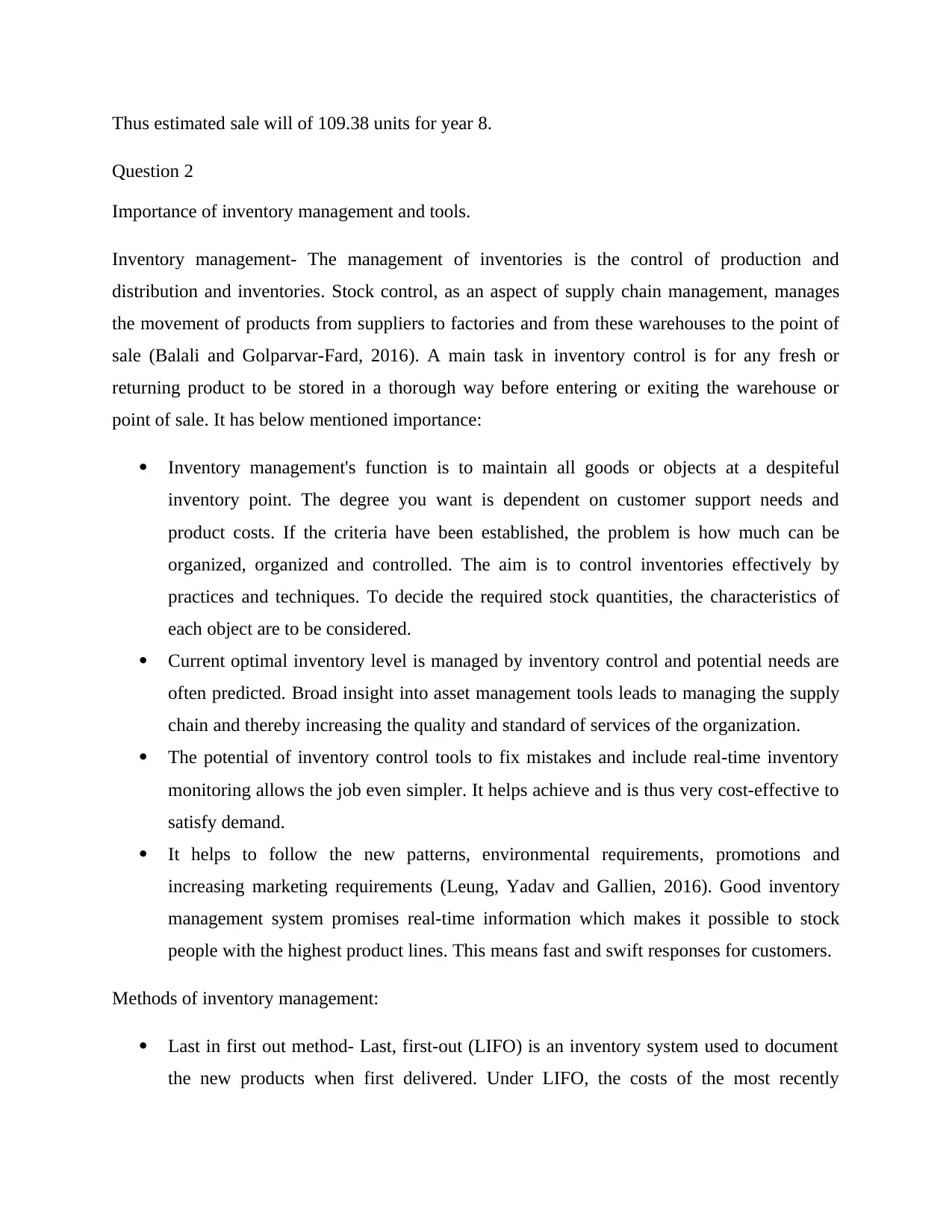
Thus estimated sale will of 109.38 units for year 8.
Question 2
Importance of inventory management and tools.
Inventory management- The management of inventories is the control of production and
distribution and inventories. Stock control, as an aspect of supply chain management, manages
the movement of products from suppliers to factories and from these warehouses to the point of
sale (Balali and Golparvar-Fard, 2016). A main task in inventory control is for any fresh or
returning product to be stored in a thorough way before entering or exiting the warehouse or
point of sale. It has below mentioned importance:
Inventory management's function is to maintain all goods or objects at a despiteful
inventory point. The degree you want is dependent on customer support needs and
product costs. If the criteria have been established, the problem is how much can be
organized, organized and controlled. The aim is to control inventories effectively by
practices and techniques. To decide the required stock quantities, the characteristics of
each object are to be considered.
Current optimal inventory level is managed by inventory control and potential needs are
often predicted. Broad insight into asset management tools leads to managing the supply
chain and thereby increasing the quality and standard of services of the organization.
The potential of inventory control tools to fix mistakes and include real-time inventory
monitoring allows the job even simpler. It helps achieve and is thus very cost-effective to
satisfy demand.
It helps to follow the new patterns, environmental requirements, promotions and
increasing marketing requirements (Leung, Yadav and Gallien, 2016). Good inventory
management system promises real-time information which makes it possible to stock
people with the highest product lines. This means fast and swift responses for customers.
Methods of inventory management:
Last in first out method- Last, first-out (LIFO) is an inventory system used to document
the new products when first delivered. Under LIFO, the costs of the most recently
Question 2
Importance of inventory management and tools.
Inventory management- The management of inventories is the control of production and
distribution and inventories. Stock control, as an aspect of supply chain management, manages
the movement of products from suppliers to factories and from these warehouses to the point of
sale (Balali and Golparvar-Fard, 2016). A main task in inventory control is for any fresh or
returning product to be stored in a thorough way before entering or exiting the warehouse or
point of sale. It has below mentioned importance:
Inventory management's function is to maintain all goods or objects at a despiteful
inventory point. The degree you want is dependent on customer support needs and
product costs. If the criteria have been established, the problem is how much can be
organized, organized and controlled. The aim is to control inventories effectively by
practices and techniques. To decide the required stock quantities, the characteristics of
each object are to be considered.
Current optimal inventory level is managed by inventory control and potential needs are
often predicted. Broad insight into asset management tools leads to managing the supply
chain and thereby increasing the quality and standard of services of the organization.
The potential of inventory control tools to fix mistakes and include real-time inventory
monitoring allows the job even simpler. It helps achieve and is thus very cost-effective to
satisfy demand.
It helps to follow the new patterns, environmental requirements, promotions and
increasing marketing requirements (Leung, Yadav and Gallien, 2016). Good inventory
management system promises real-time information which makes it possible to stock
people with the highest product lines. This means fast and swift responses for customers.
Methods of inventory management:
Last in first out method- Last, first-out (LIFO) is an inventory system used to document
the new products when first delivered. Under LIFO, the costs of the most recently
⊘ This is a preview!⊘
Do you want full access?
Subscribe today to unlock all pages.

Trusted by 1+ million students worldwide
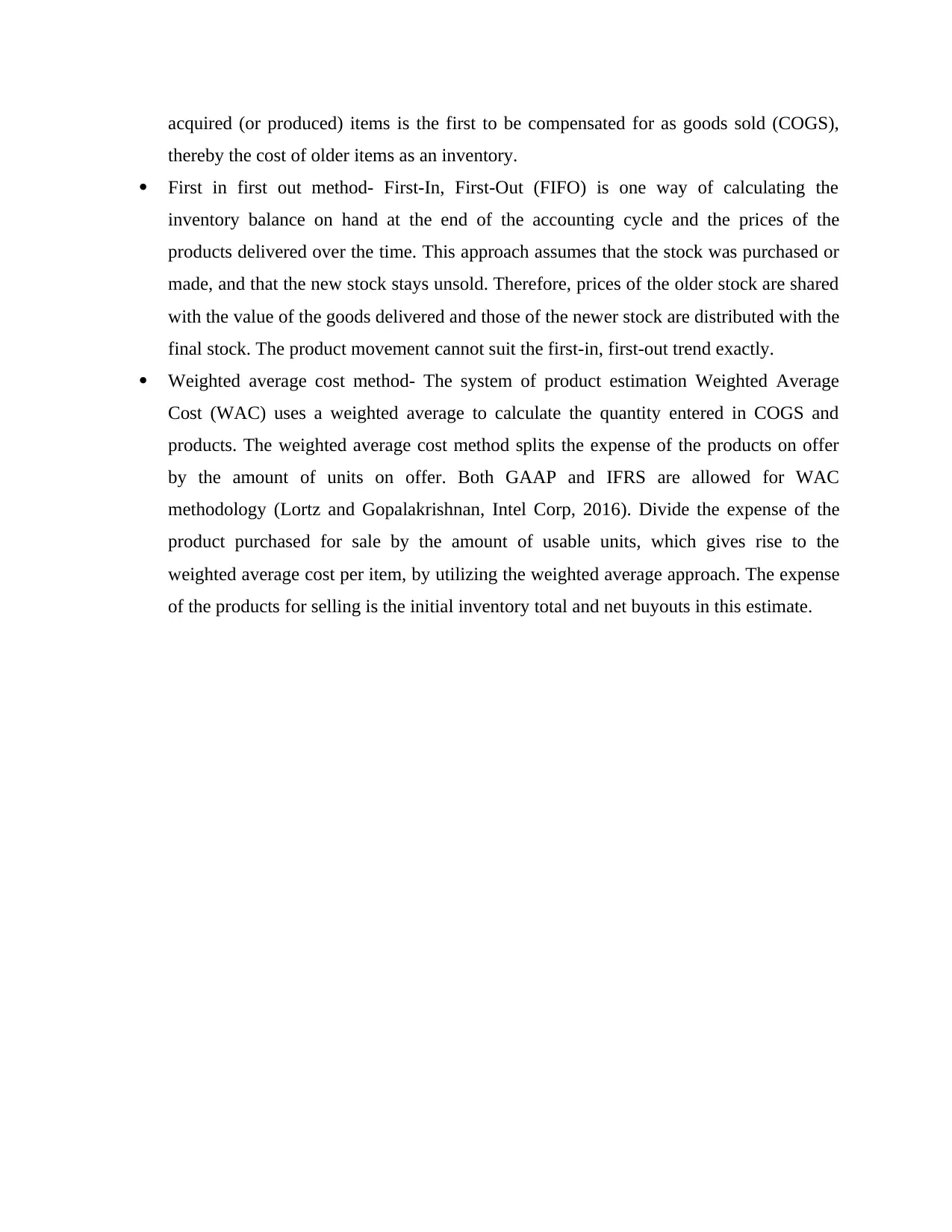
acquired (or produced) items is the first to be compensated for as goods sold (COGS),
thereby the cost of older items as an inventory.
First in first out method- First-In, First-Out (FIFO) is one way of calculating the
inventory balance on hand at the end of the accounting cycle and the prices of the
products delivered over the time. This approach assumes that the stock was purchased or
made, and that the new stock stays unsold. Therefore, prices of the older stock are shared
with the value of the goods delivered and those of the newer stock are distributed with the
final stock. The product movement cannot suit the first-in, first-out trend exactly.
Weighted average cost method- The system of product estimation Weighted Average
Cost (WAC) uses a weighted average to calculate the quantity entered in COGS and
products. The weighted average cost method splits the expense of the products on offer
by the amount of units on offer. Both GAAP and IFRS are allowed for WAC
methodology (Lortz and Gopalakrishnan, Intel Corp, 2016). Divide the expense of the
product purchased for sale by the amount of usable units, which gives rise to the
weighted average cost per item, by utilizing the weighted average approach. The expense
of the products for selling is the initial inventory total and net buyouts in this estimate.
thereby the cost of older items as an inventory.
First in first out method- First-In, First-Out (FIFO) is one way of calculating the
inventory balance on hand at the end of the accounting cycle and the prices of the
products delivered over the time. This approach assumes that the stock was purchased or
made, and that the new stock stays unsold. Therefore, prices of the older stock are shared
with the value of the goods delivered and those of the newer stock are distributed with the
final stock. The product movement cannot suit the first-in, first-out trend exactly.
Weighted average cost method- The system of product estimation Weighted Average
Cost (WAC) uses a weighted average to calculate the quantity entered in COGS and
products. The weighted average cost method splits the expense of the products on offer
by the amount of units on offer. Both GAAP and IFRS are allowed for WAC
methodology (Lortz and Gopalakrishnan, Intel Corp, 2016). Divide the expense of the
product purchased for sale by the amount of usable units, which gives rise to the
weighted average cost per item, by utilizing the weighted average approach. The expense
of the products for selling is the initial inventory total and net buyouts in this estimate.
Paraphrase This Document
Need a fresh take? Get an instant paraphrase of this document with our AI Paraphraser
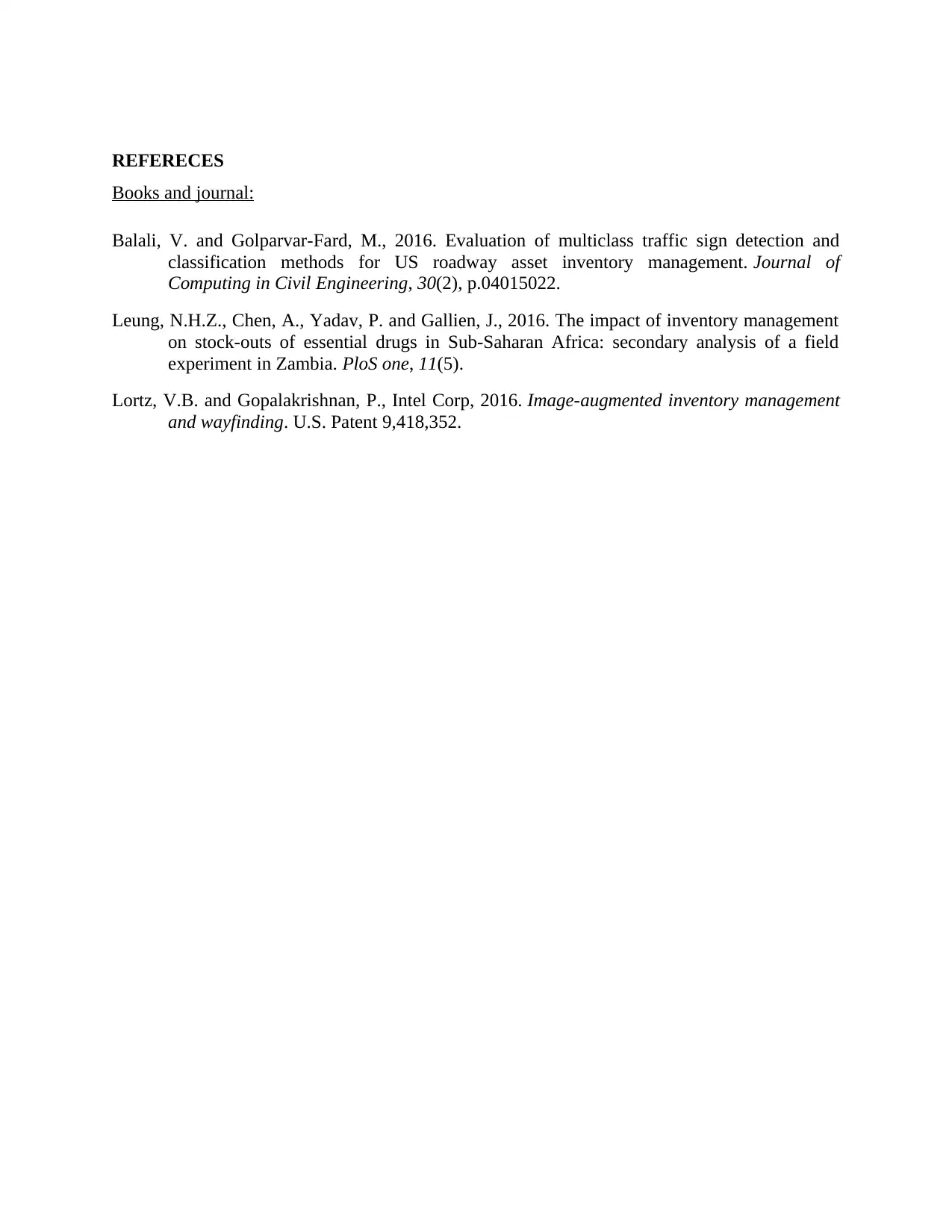
REFERECES
Books and journal:
Balali, V. and Golparvar-Fard, M., 2016. Evaluation of multiclass traffic sign detection and
classification methods for US roadway asset inventory management. Journal of
Computing in Civil Engineering, 30(2), p.04015022.
Leung, N.H.Z., Chen, A., Yadav, P. and Gallien, J., 2016. The impact of inventory management
on stock-outs of essential drugs in Sub-Saharan Africa: secondary analysis of a field
experiment in Zambia. PloS one, 11(5).
Lortz, V.B. and Gopalakrishnan, P., Intel Corp, 2016. Image-augmented inventory management
and wayfinding. U.S. Patent 9,418,352.
Books and journal:
Balali, V. and Golparvar-Fard, M., 2016. Evaluation of multiclass traffic sign detection and
classification methods for US roadway asset inventory management. Journal of
Computing in Civil Engineering, 30(2), p.04015022.
Leung, N.H.Z., Chen, A., Yadav, P. and Gallien, J., 2016. The impact of inventory management
on stock-outs of essential drugs in Sub-Saharan Africa: secondary analysis of a field
experiment in Zambia. PloS one, 11(5).
Lortz, V.B. and Gopalakrishnan, P., Intel Corp, 2016. Image-augmented inventory management
and wayfinding. U.S. Patent 9,418,352.
1 out of 8
Your All-in-One AI-Powered Toolkit for Academic Success.
+13062052269
info@desklib.com
Available 24*7 on WhatsApp / Email
![[object Object]](/_next/static/media/star-bottom.7253800d.svg)
Unlock your academic potential
Copyright © 2020–2025 A2Z Services. All Rights Reserved. Developed and managed by ZUCOL.